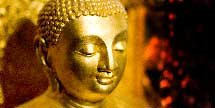A Suitable Place for Meditation

A Suitable Place to practice meditation (by U Hla Myint)
When the Buddha taught us how to develop mindfulness of breathing, he first mentioned the preparation for this efficient practice as follows:
Kathañca pana, bhikkhave, bhikkhu kāye kāyānupassī viharati? Idha, bhikkhave, bhikkhu araññagato vā rukkhamūlagato vā suññāgāragato vā nisīdati pallaṅkaṃ ābhujitvā ujuṃ kāyaṃ paṇidhāya parimukhaṃ satiṃ upaṭṭhapetvā.
And how, monks, does a monk dwell (spend his time) contemplating the body in the body? Here now, monks, a monk having gone to the forest, to the root of a tree, or to an empty hut (or secluded place), sits down folding his legs crosswise, setting his upper body erect, and directing the mindfulness toward (the meditative object).
The above passage mentions the preparation procedure in three stages:
- Go to the forest, the root of a tree or an empty hut
- Sit with legs crossed and upper part of body kept straight
- Direct the mindfulness toward (the meditative object)
Go to the Forest, the Root of a Tree or an Empty Hut
First of all, the Buddha mentioned suitable places for us to practice thus: “Having gone to the forest, to the root of a tree, or to an empty hut[1] (secluded place).” To make a faster progress in the practice requires a quiet and secluded place like a forest, root of a tree, or an empty hut and so on[2]. Seclusion is very important, especially for beginners whose minds are easily agitated or affected by distractions, like noises and people around. This reminds me of an incident.
One day, an attractive and well-dressed woman came to the Panditarama meditation center and requested Venerable Sayadaw U Paṇḍitābhivamsa to send a meditation master to teach at her hotel, one of the few five-star hotels in Yangon, Burma. She said she was the manager of the hotel and wanted Vipassana meditation accessible to her customers, since it was something unique to Burma. Sayadaw rejected her request right away. As a translator sitting nearby, I humbly requested him to reconsider his decision, because I thought, to make the teachings available in such a prestigious hotel would really be something special. But he firmly said: “A luxury hotel was a place suitable to enjoy sensual pleasure but not to practice meditation.”
Of course, meditation practice is unsuitable not only in a luxury hotel like this but also in any other environment where there are people and noises around, like our home where there are our beloved family members around, and in our offices where there are people and noises surrounding us. As an example of suitable places, the Buddha mentioned a forest, a tree and an empty hut. Nowadays, it would be very hard for us to practice under the tree or in the forest, especially in western countries. Fortunately, however, there are many meditation centers that provide us secluded environments for practice. They are, of course, the best substitutes for forests and trees. In our houses, an empty room during the quiet hours is an exact substitute for an empty hut, of course. If we have good training in the practice, however, we can develop mindfulness, even while we are standing in a queue, or in a waiting room crowded with peoples, for instance. In bed, it can be very blissful to develop the mindfulness of breath, as it makes our minds calm, and may lead to a sound sleep in the end, even if no better benefits are attained.
[1] “Empty hut” is a literal translation of “suññā-gāra,” which is generally translated as “secluded place.”
[2] There are some other secluded places mentioned in the other suttas, such as a hill cleft, a mountain cave, a charnel ground, a jungle thicket, open space, and so on.
